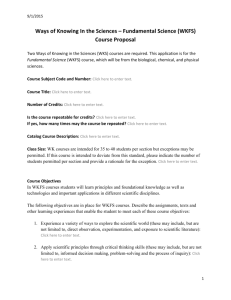AP Physics 1 Sample Syllabus 4
advertisement
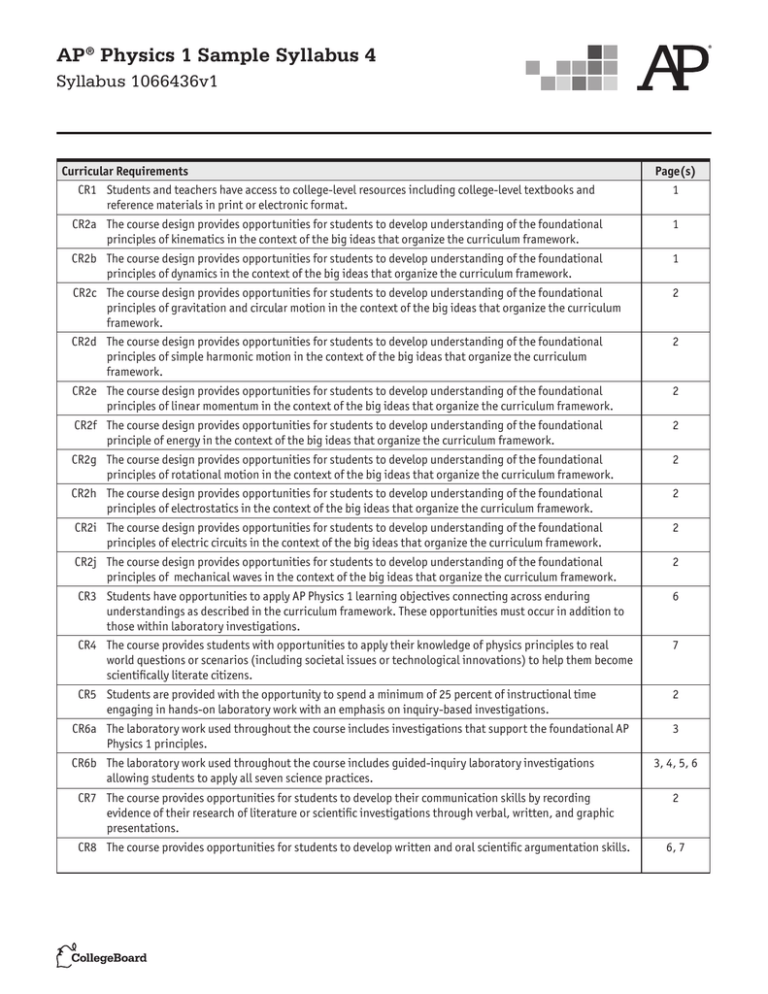
AP® Physics 1 Sample Syllabus 4 Syllabus 1066436v1 Curricular Requirements CR1 Students and teachers have access to college-level resources including college-level textbooks and reference materials in print or electronic format. 1 CR2a The course design provides opportunities for students to develop understanding of the foundational principles of kinematics in the context of the big ideas that organize the curriculum framework. 1 CR2b The course design provides opportunities for students to develop understanding of the foundational principles of dynamics in the context of the big ideas that organize the curriculum framework. 1 CR2c The course design provides opportunities for students to develop understanding of the foundational principles of gravitation and circular motion in the context of the big ideas that organize the curriculum framework. 2 CR2d The course design provides opportunities for students to develop understanding of the foundational principles of simple harmonic motion in the context of the big ideas that organize the curriculum framework. 2 CR2e The course design provides opportunities for students to develop understanding of the foundational principles of linear momentum in the context of the big ideas that organize the curriculum framework. 2 CR2f The course design provides opportunities for students to develop understanding of the foundational principle of energy in the context of the big ideas that organize the curriculum framework. 2 CR2g The course design provides opportunities for students to develop understanding of the foundational principles of rotational motion in the context of the big ideas that organize the curriculum framework. 2 CR2h The course design provides opportunities for students to develop understanding of the foundational principles of electrostatics in the context of the big ideas that organize the curriculum framework. 2 CR2i The course design provides opportunities for students to develop understanding of the foundational principles of electric circuits in the context of the big ideas that organize the curriculum framework. 2 CR2j The course design provides opportunities for students to develop understanding of the foundational principles of mechanical waves in the context of the big ideas that organize the curriculum framework. 2 CR3 Students have opportunities to apply AP Physics 1 learning objectives connecting across enduring understandings as described in the curriculum framework. These opportunities must occur in addition to those within laboratory investigations. 6 CR4 The course provides students with opportunities to apply their knowledge of physics principles to real world questions or scenarios (including societal issues or technological innovations) to help them become scientifically literate citizens. 7 CR5 Students are provided with the opportunity to spend a minimum of 25 percent of instructional time engaging in hands-on laboratory work with an emphasis on inquiry-based investigations. 2 CR6a The laboratory work used throughout the course includes investigations that support the foundational AP Physics 1 principles. CR6b The laboratory work used throughout the course includes guided-inquiry laboratory investigations allowing students to apply all seven science practices. CR7 The course provides opportunities for students to develop their communication skills by recording evidence of their research of literature or scientific investigations through verbal, written, and graphic presentations. CR8 The course provides opportunities for students to develop written and oral scientific argumentation skills. 1 Page(s) 3 3, 4, 5, 6 2 6, 7 AP® Physics 1 Sample Syllabus 4 Syllabus 1066436v1 Course Introduction Textbook: Cutnell, John and Kenneth Johnson. Physics. 6th Edition. New York: John Wiley & Sons, Inc., 2004. [CR1] About this course: The AP Physics 1 course will meet for 41 minutes every day. Lab work is integral to the understanding of the concepts in this course. The AP Physics 1 Course has been designed by the College Board as a course equivalent to the algebra-based college-level physics class. At the end of the course, students will take the AP Physics 1 Exam, which will test their knowledge of both the concepts taught in the classroom and their use of the correct formulas. CR1— Students and teachers have access to college-level resources including college-level textbooks and reference materials in print or electronic format. The content for the course is based on six big ideas: Big Idea 1 – Objects and systems have properties such as mass and charge. Systems may have internal structure. Big Idea 2 – Fields existing in space can be used to explain interactions. Big Idea 3 – The interactions of an object with other objects can be described by forces. Big Idea 4 – Interactions between systems can result in changes in those systems. Big Idea 5 – Changes that occur as a result of interactions are constrained by conservation laws. Big Idea 6 – Waves can transfer energy and momentum from one location to another without the permanent transfer of mass and serve as a mathematical model for the description of other phenomena. Evaluation: Students will get grades on homework, quizzes, laboratory work, projects, and exams. Exams are typically worth 100 points and will consist of questions similar to ones students will see on the AP Exam. Homework assignments and quizzes will consist of problems from the textbook, supplements, and old AP Exams. Projects are long-term, and typically will involve groups of students developing a plan, collecting data and/or research, and presenting conclusions in a meaningful way. Laboratory work is student centered and inquiry based and is discussed below. Grades will be determined by taking the number of points a student has earned and dividing it by the total number of points that the student could have achieved. This decimal is multiplied by 100, and that will be the student’s grade. Topics Covered: 1. Kinematics (Big Idea 3) [CR2a] a. Vectors/Scalars b. One Dimensional Motion (including graphing position, velocity, and acceleration) c. Two Dimensional Motion 2. Dynamics (Big Ideas 1, 2, 3, and 4) [CR2b] CR2a— The course design provides opportunities for students to develop understanding of the foundational principles of kinematics in the context of the big ideas that organize the curriculum framework. CR2b—The course design provides opportunities for students to develop understanding of the foundational principles of dynamics in the context of the big ideas that organize the curriculum framework. 1 AP® Physics 1 Sample Syllabus 4 a. Newton’s Laws of Motion and Forces 3. Universal Law of Gravitation (Big Ideas 1, 2, 3, and 4) [CR2c] a. Circular Motion 4. Simple Harmonic Motion (Big Ideas 3 and 5) [CR2d] a. Simple Pendulums b. Mass-Spring Oscillators 5. Momentum (Big Ideas 3, 4, and 5) [CR2e] a. Impulse and Momentum b. The Law of Conservation of Momentum 6. Energy (Big Ideas 3, 4, and 5) [CR2f] a. Work b. Energy c. Conservation of Energy d. Power 7. Rotation (Big Ideas 3, 4, and 5) [CR2g] a. Rotational Kinematics b. Rotational Energy c. Torque and Rotational Dynamics d. Angular Momentum e. Conservation of Angular Momentum 8. Electrostatics (Big Ideas 1, 3, and 5) [CR2h] a. Electric Charge b. The Law of Conservation of Electric Charge c. Electrostatic Forces 9. Circuits (Big Ideas 1 and 5) [CR2i] a. Ohm’s Law b. Kirchhoff’s Laws c. Simple DC Circuits 10. Mechanical Waves and Sound (Big Idea 6) [CR2j] Laboratory Activities: Students will spend twenty five percent of the course engaged in hands-on laboratory work. [CR5] Labs may take several in-class days to finish, and students may have to do work outside of class as well. Students are expected to keep a lab notebook where they will maintain a record of their laboratory work. Lab reports will consist of the following components: [CR7] - Title - Objective/Problem - Design (if applicable): If the lab has no set procedure, what is to be done? Why are you doing it this way? - Data: All data gathered in the lab will go here - Calculations/Graphs: Calculations are done here. Any graphs that need to be made go here. - Conclusion: Data analysis occurs here, and a statement can be made about what was learned in the lab. Error analysis also occurs here. Evaluation of the lab occurs here as well. Syllabus 1066436v1 CR2c— The course design provides opportunities for students to develop understanding of the foundational principles of gravitation and circular motion in the context of the big ideas that organize the curriculum framework. CR2d— The course design provides opportunities for students to develop understanding of the foundational principles of simple harmonic motion in the context of the big ideas that organize the curriculum framework. CR2e— The course design provides opportunities for students to develop understanding of the foundational principles of linear momentum in the context of the big ideas that organize the curriculum framework. CR2f— The course design provides opportunities for students to develop understanding of the foundational principle of energy in the context of the big ideas that organize the curriculum framework. CR2g— The course design provides opportunities for students to develop understanding of the foundational principles of rotational motion in the context of the big ideas that organize the curriculum framework. CR2h— The course design provides opportunities for students to develop understanding of the foundational principles of electrostatics in the context of the big ideas that organize the curriculum framework. CR2i— The course design provides opportunities for students to develop understanding of the foundational principles of electric circuits in the context of the big ideas that organize the curriculum framework. 2 AP® Physics 1 Sample Syllabus 4 Syllabus 1066436v1 Every major unit will have an inquiry-based lab, and inquiry-based labs will make up no less than half of the laboratory work. Collectively, laboratory work will engage students in all seven science practices. Laboratory activities and simulations in this class are included the following table. [CR6a] The inquiry-based labs are noted in the second column. Name #1 Speed Lab OpenInquiry or GuidedInquiry? [CR6b] Y Short Description Students will design an experiment to determine the range of speeds of a variable speed cart. Science Practices 2.1, 2.2, 4.1, 4.2, 4.3 CR2j— The course design provides opportunities for students to develop understanding of the foundational principles of mechanical waves in the context of the big ideas that organize the curriculum framework. CR5— Students are provided with the opportunity to spend a minimum of 25 percent of instructional time engaging in hands-on laboratory work with an emphasis on inquiry-based investigations. Three Cars Racing Simulation N A computer simulation of three 1.4, 2.2, 4.3, 6.1 cars with different accelerations racing. #2 Rocket Lab Y 1.2, 1.4, 2.1, Students will design an 2.2, 4.1, 4.2, 4.3 experiment to determine the initial velocity of an air-powered rocket. CR7— The course provides opportunities for students to develop their communication skills by recording evidence of their research of literature or scientific investigations through verbal, written, and graphic presentations. #3 Marble in Cup Lab N Students will determine where a paper cup needs to be placed on the floor so that a marble rolled off of the edge of a table will land in it. 1.4, 2.1, 2.2, 2.3, 4.3 CR6a— The laboratory work used throughout the course includes investigations that support the foundational AP Physics 1 principles. #4 Projectile Motion Challenges Y Using a projectile launcher, 1.4, 2.1, 2.2, students will be given a series of 4.1, 4.2, 4.3 challenges such as placing a ring stand at the maximum height, or placing a cup at the point where the marble will land. CR6b— The laboratory work used throughout the course includes guided-inquiry laboratory investigations allowing students to apply all seven science practices. #5 Newton’s 2nd Law Lab Y What is the relationship between 1.1, 1.4, 2.1, 2.2, the mass of a system and the 3.3, 4.1, 4.2, acceleration of the system? 4.3, 4.4, 5.1, 6.1, 6.2, 6.4 3 AP® Physics 1 Sample Syllabus 4 Name OpenInquiry or GuidedInquiry? [CR6b] Syllabus 1066436v1 Short Description Science Practices Forces on a Crate Simulation N Using a simulation, analyze the motion of a crate. Students can vary the force on the crate, the direction of that force, the initial velocity of the crate, and the coefficient of kinetic friction. 1.1, 1.4, 2.2, 4.3, 6.1 Jupiter’s Moons N Students will do research on Jupiter and four of its moons. Based on this research, students will mathematically come up with the mass of Jupiter. They will compare this information to the accepted value. 1.1, 1.4, 2.1, 2.2, 3.3, 4.1, 4.2, 4.3, 4.4, 5.1, 6.1, 6.2, 6.4, 7.1 #6 Pendulum Lab Y What factor(s) control the period of a simple pendulum? 1.1, 1.4, 2.1, 2.2, 3.3, 4.1, 4.2, 4.3, 4.4, 5.1, 6.1, 6.2, 6.4 #7 Mass-Spring Oscillator Lab Y 1.1, 1.4, 2.1, 2.2, 3.3, 4.1, 4.2, 4.3, 4.4, 5.1, 6.1, 6.2, 6.4 #8 Conservation of Linear Momentum Lab Y Students must determine both the spring constant k of a spring and the mass of three unknown masses. Students must also investigate the conservation of mechanical energy of the system. Materials given: spring with unknown spring constant, known masses, unknown masses. Using a track and collision carts, students will observe seven different collisions and make conclusions about momentum conservation in real life situations. CR6b— The laboratory work used throughout the course includes guided-inquiry laboratory investigations allowing students to apply all seven science practices. 1.1, 1.4, 2.1, 2.2, 3.3, 4.1, 4.2, 4.3, 4.4, 5.1, 6.1, 6.2, 6.4, 7.2 4 AP® Physics 1 Sample Syllabus 4 Name OpenInquiry or GuidedInquiry? [CR6b] A Two Car Collision N Simulation Syllabus 1066436v1 Short Description Science Practices Students will observe a simulation of two identical cars crashing. The elasticity of the collision can be varied. 1.1, 1.4, 2.2, 4.3, 6.1 #9 Introductory Circular Motion Lab Y When velocity is kept constant, what is the relationship between the radius of circular motion and the period of circular motion? The speed? The acceleration? 1.1, 1.4, 2.1, 2.2, 3.3, 4.1, 4.2, 4.3, 4.4, 5.1, 6.1, 6.2, 6.4 #10 Centripetal Force Lab Y Using a spinning rubber stopper to lift masses, students will determine the relationship between the acceleration of the stopper and the centripetal force. 1.1, 1.4, 2.1, 2.2, 3.3, 4.1, 4.2, 4.3, 4.4, 5.1, 6.1, 6.2, 6.4 #11 Conservation of Angular Momentum Lab Y What is the relationship between the moment of inertia of a system and the angular momentum of a system? 1.1, 1.4, 2.1, 2.2, 3.3, 4.1, 4.2, 4.3, 4.4, 5.1, 6.1, 6.2, 6.4 Torque Simulation N Students will use a computer simulation to study rotational equilibrium. 1.1, 1.4, 2.2, 4.3, 6.1 #12 Coulomb’s Law Lab Y What is the charge stored on a 1.1, 1.4, 2.1, 2.2, pair of charged balloons that are 3.3, 4.1, 4.2, repelling each other? 4.3, 4.4, 5.1, 6.1, 6.2, 6.4 Electrostatics Simulation N Using a computer simulation involving two positive charges, explore the electrostatic force of repulsion between the charges, the accelerations of the charges, and how the force and acceleration changes with distance. CR6b— The laboratory work used throughout the course includes guided-inquiry laboratory investigations allowing students to apply all seven science practices. 1.1, 1.4, 2.1, 2.2, 3.3, 4.1, 4.2, 4.3, 4.4, 5.1, 6.1, 6.2, 6.4 5 AP® Physics 1 Sample Syllabus 4 Name OpenInquiry or GuidedInquiry? [CR6b] Syllabus 1066436v1 Short Description Science Practices #13 Series and Parallel Lab Y Using a number of resistors, explore current and voltage in resistors hooked up to a power supply when resistors are wired in series with one another and when they are wired in parallel with one another. 1.1, 1.4, 2.1, 2.2, 3.3, 4.1, 4.2, 4.3, 4.4, 5.1, 6.1, 6.2, 6.4 #14 Standing Waves on a Wire Lab Y Students will vary wavelength, frequency, and the tension in a wire while looking at standing waves formed on a wire. 1.1, 1.4, 2.1, 2.2, 3.3, 4.1, 4.2, 4.3, 4.4, 5.1, 6.1, 6.2, 6.4 #15 Standing Sound Waves in a Tube Lab N Students will vary the frequency 1.1, 1.4, 2.1, 2.2, of sound coming out of a speaker 3.3, 4.1, 4.4, 5.1, 6.1, 6.2, 6.4 to create standing waves in a tube to determine the speed of sound in the classroom. Outside the Classroom Lab Experience: [CR3] In addition to labs, students will be required to do one exercise outside of the laboratory experience. Students may pick one of the following at the end of our rotation unit (end of mechanics): - Students will use a video analysis program (Videopoint) to analyze the motion of a toy as it moves (either in a straight line or in a circle). Students will provide the toy and do their own videotaping. They will then present a description of the analysis both quantitatively and qualitatively, including graphs. Their presentation will be peer critiqued and/or questioned, and they will answer the questions with supporting evidence. [CR8] (3.A.1.1, 3.A.1.3, 1.C.1.1) - Using an accelerometer app for their smart phone (SPARKvue is one), students will analyze accelerations they experience every day. They can take the data while moving down the hall between classes, while on the school bus, on an amusement park ride, or anything else they want (within reason – safety first!). Students will present a description of the motion they experienced (not only acceleration, but velocity and displacement, too), both quantitatively and quantitatively, including graphs. Their presentation will be peer critiqued and/or questioned, and they will answer the questions with supporting evidence. [CR8] (3.A.1.1, 3.A.1.3, 1.C.1.1) - Students will take two pictures – one of an object in translational equilibrium, and one of an object in rotational equilibrium. The objects also must have more CR6b— The laboratory work used throughout the course includes guided-inquiry laboratory investigations allowing students to apply all seven science practices. CR3— Students have opportunities to apply AP Physics 1 learning objectives connecting across enduring understandings as described in the curriculum framework. These opportunities must occur in addition to those within laboratory investigations. CR8— The course provides opportunities for students to develop written and oral scientific argumentation skills. 6 AP® Physics 1 Sample Syllabus 4 than three forces acting on them. They will then construct free-body diagrams for each object, and determine the magnitude of each force acting on each object. For the object in rotational equilibrium, students will also find the magnitude of each torque acting on the object. Students will present their work in class. Their presentation will be peer critiqued and/or questioned, and they will answer the questions with supporting evidence. [CR8] (3.B.1.3, 3.B.2.1, 3.F.1.1, 3.F.1.2, 3.F.1.5) Real World Physics Solutions: In order for students to become scientifically literate citizens, students are required to use their knowledge of physics while looking at a real world problem. [CR4] Students may pick one of the following solutions: - Students will pick a Hollywood movie and will point out three (or more) instances of bad physics. They will present this information to the class, describing the inaccuracies both qualitatively and quantitatively. - Students will research a thrill ride at an amusement park. They will present information to the class on the safety features of the ride, and why they are in place. - Students will present information to the class on noise pollution, and it’s danger to both human and animal life. They will also propose solutions to noise pollution problems. - Students will go to the insurance institute of highway safety website (iihs.org) and will look at the safest cars in a crash. They will present information as to why these cars are safer and how the safety features keep people safe. Syllabus 1066436v1 CR8— The course provides opportunities for students to develop written and oral scientific argumentation skills. CR4— The course provides students with opportunities to apply their knowledge of physics principles to real world questions or scenarios (including societal issues or technological innovations) to help them become scientifically literate citizens. 7
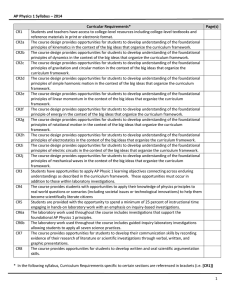
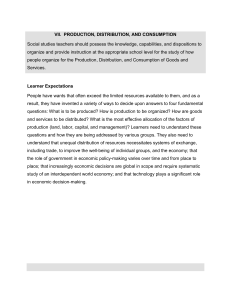
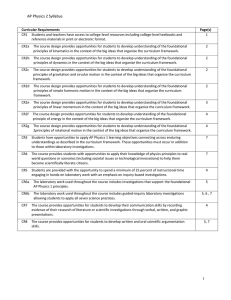
![[Course information: prefix, number, title, credits] GENERAL EDUCATION COMPETENCY AREA:](http://s2.studylib.net/store/data/015759506_1-897e653fa9d8b4d146755dfb01d20713-300x300.png)
